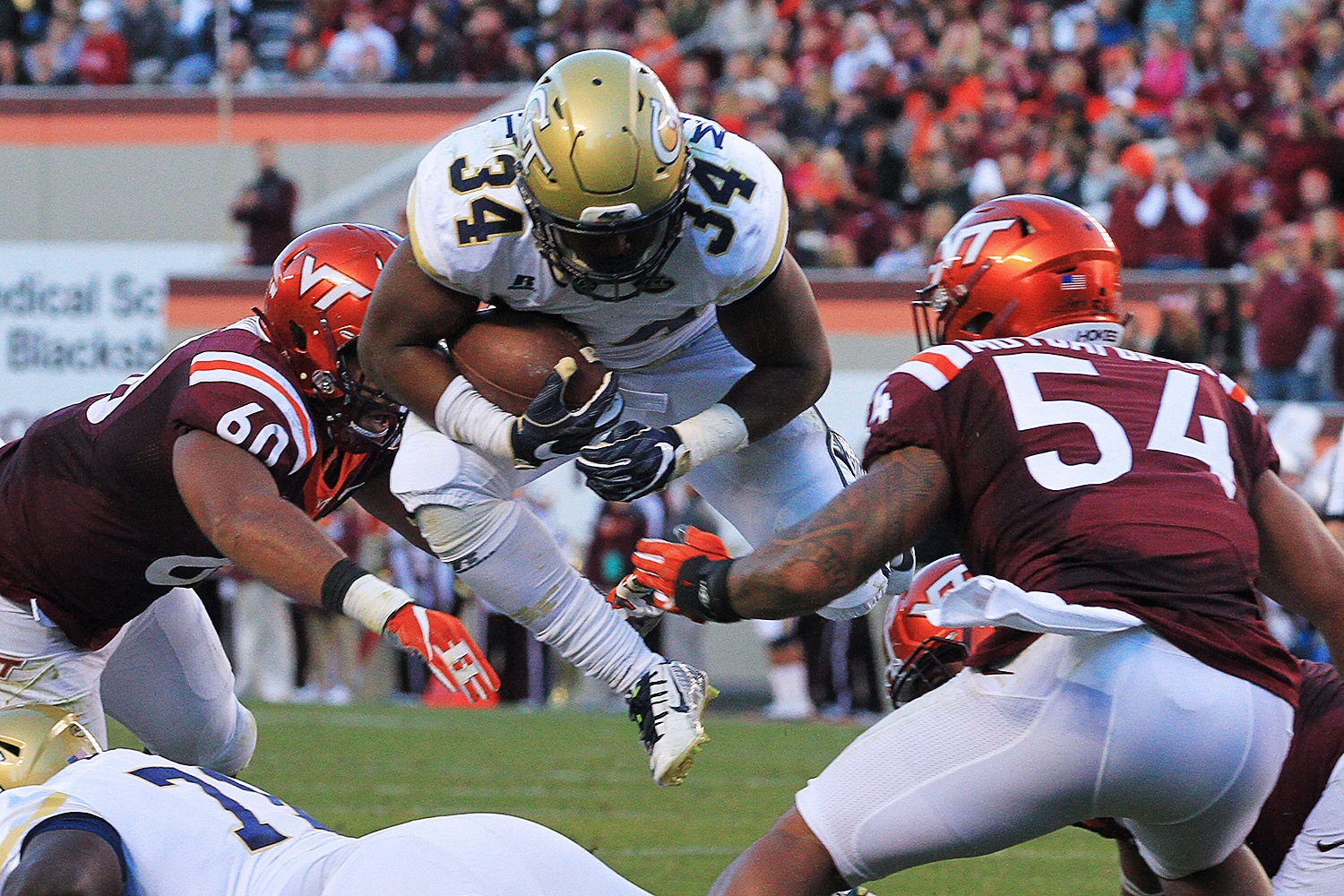
Any time a team plays Georgia Tech, game preparation gets a little hectic.
As most college teams transition, or have already transitioned, to a spread-style offense, Georgia Tech is the stubborn fellow in the room clinging to their ways.
What’s their way? The option.
The option offense used to be the calling card of high school and college teams across the country. Whether it was the veer at West Virginia in the 1960s or 1970s, or the wishbone at Nebraska that helped the Cornhuskers become a college football powerhouse, the option has been a staple in college football for a long time. At least until recently.
Now, you can count on one hand the number of FBS teams than primarily run an option-based offense. The military academies come to mind, but Paul Johnson and Georgia Tech’s spread option attack is the only one of its kind still used at the Power 5 level.
Fortunately for Virginia Tech, defensive coordinator Bud Foster has seen Johnson and his option offense many times. Johnson was hired by the Yellow Jackets in 2008, and Foster has faced off against him Johnson every single season since then.
“These guys, they’re well-coached, they’re tough, they’re physical, they execute, and Paul has seen I think everything under the sun thrown at him, trying to defend this option,” Foster said. “We’ve been a part of that too, trying to change up things or tweak things. As far as their play concepts, as far as running the triple option, obviously they have some counters and some misdirections and those type of things. Where they’re different and unique week-to-week, year-to-year, is some of the blocking combinations and schemes that they do, trying to attack what you’re showing, and how they want to attack you with certain looks…where he can see where you’re trying to gain that extra hitter, and them trying to manipulate where they can get a hat on that guy. That’s what he’s done against us, and what he’s done against everybody else.”
Georgia Tech’s spread option offense is unlike anything Virginia Tech sees all season. And the Hokies only get one week a year to prepare.
“Once you see it on Saturday, and we’re going to be practicing it Tuesday, today, and working hard on it all week,” said defensive line coach Charley Wiles. “You’ll see it on Saturday, and it’s just like so much faster. Hard, hard to simulate. It doesn’t get easier. For a team that doesn’t play a triple option team, it’s going to be very difficult, because it’s such trial and error I think.”
Over the years, Virginia Tech has developed a set of principles when facing Georgia Tech’s option. Perhaps the most important of those is maintaining gap fits and being disciplined on defense.
“It’s critical,” Foster said. “Last year, one of the runs that popped, our backside safety kind of over-pursued a little bit. That can happen with this style of offense, particularly with them going outside, outside, outside and then popping it up inside. Or, inside, inside, inside and then outside. That’s where you’ve just got to be disciplined and have good leverage. And they’re going to make some plays. That’s the thing about this offense. We can’t get frustrated over a four-yard gain. Sometimes, that’s good defense against these guys. But we’ve got to eliminate the 40-yard plays.”
Those 40-yard plays were the ones that sank Virginia Tech last season. Georgia Tech scored two touchdowns last season from 53 and 56 yards, as the Hokies struggled to stop the Yellow Jackets’ unique attack in a 30-20 defeat that wasn’t as close as the score would lead you to believe.

“It’s just not being gap sound,” said linebacker Andrew Motuapuaka. “It’s just somebody not doing their job, not doing their technique correctly or just being out of place.”
If you remove those two plays, Virginia Tech allowed just 3.5 yards per rush on 56 carries, which is more than adequate. But those two big plays changed everything.
“So, if we can keep them into that, that’s kind of our target area, if we can keep them in the 250 or less in the run game, depending on how many plays they run, and we can eliminate the explosive plays, that’s how we’ve had success,” Foster said. “But there’s also where the challenge lies, making sure you can come off blocks and making sure we get great reads, and making sure we’re fitting properly and being disciplined.”
Poor discipline and technique can lead to you getting cut-blocked. Georgia Tech’s offense thrives off the cut block, which aims to take defenders out of the play by going at their knees, instead of blocking them up high like normal.
“We’re not on the ground when we’re practicing, so it’s hard that way. Because inside, especially, it is rugged in there and it is very physical,” Wiles said. “Lot of chopping and a lot of that going on, a lot of people on the ground, so it’s very difficult to simulate. And again, Georgia Tech is very rugged on the offensive line. They are physical.”
Motuapuaka, who’s seen Georgia Tech’s option three times in his career, says cut blocks are not only annoying but potentially dangerous, if you aren’t paying attention.
“Each cut block is a potential — it could hurt you just for that play, or however long,” Motuapuaka said. “So, making sure your eyes are right, playing with your hands and stuff like that would be the best way to defeat those, but those are pretty scary.”
As Virginia Tech prepares for Georgia Tech’s run-heavy offense, the Hokies are turning to a special scout team quarterback in freshman wide receiver Kalil Pimpleton. The 5-foot-8, 170-pound Pimpleton not only resembles Georgia Tech quarterback TaQuon Marshall’s size — Marshall is listed at 5-foot-10 and 185 pounds — but also knows how to play as a running quarterback. Pimpleton played quarterback, among other positions, at Muskegon High School in Michigan and was one of the most explosive players in the state.
Pimpleton will need to be on his A-game this week in practice. While Marshall has his limitations as a passer, his explosiveness and athleticism reminds Foster of former Georgia Tech quarterback Justin Thomas, who beat the Hokies in 2014.
“He’s got great speed, great acceleration, he’s a threat to go the distance every time he has the ball in his hands,” Foster said of Marshall. “He’s a more than adequate thrower. I’m sure there’s guys at that spot that have thrown the ball a little bit better, but that doesn’t take away that he’s capable of hitting the home run ball, and we’ve got to be disciplined.”
This odd and unique challenge in front of Virginia Tech couldn’t come at a more critical time. With the Coastal Division no longer in their reach, the Hokies have to take a stand and get the season back on the right track. If not, they could see a disappointing end to what was once a promising season.
“It’s not enough to finish 7-6 at this point,” said defensive end Vinny Mihota. “We still have an opportunity to go 11-2, and send these seniors out right. I think we’re very hungry, and I don’t think it’ll be an issue at all.”











Tech Sideline is Presented By: